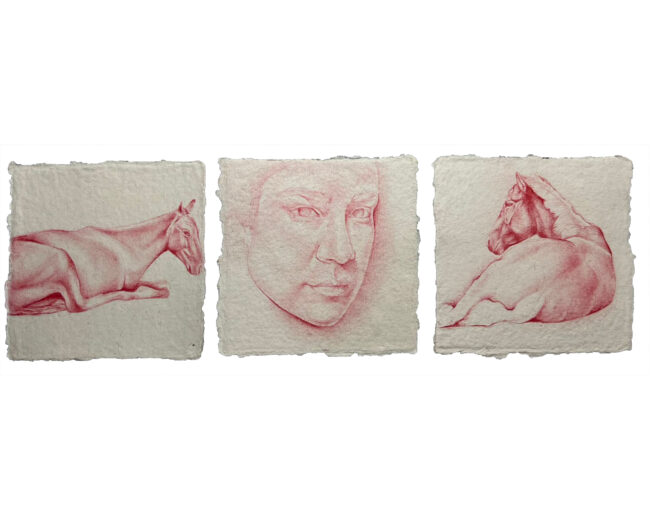'Where Walls Dissolve' is a group show curated by Laiba Aslam at That Studio in Lahore comprising of thought-provoking artworks by women artists.
‘Where Walls Dissolve’ is a group show curated by Laiba Aslam at That Studio in Lahore comprising of thought-provoking artworks by women artists.
An all-women artist lineup exhibited their works in the peculiar space of That Studio in collaboration with an artist-led initiative June Collective. The exhibition “Where Walls Dissolve…” showcases artists who challenge the boundaries between public and private through their work, underscoring the way women reside, resist, and redefine spaces. The diverse mediums reveal the intersections of gender, control, and space, inviting viewers to reconsider the relationships among these elements in contemporaneity.
Show curator and exhibiting Lahore-based artist Laiba Aslam recalled her journey of moving to a new country after marriage highlighting the kitchen as a significant symbol of change. In her new living arrangement, she encounters a shared kitchen; an unknown and communal space that interrupts the comfort and privacy linked to the environment of her home in Lahore. This shift represents not only a physical move but also an emotional transformation, often causing feelings of displacement and vulnerability, serving the kitchen as both a concrete and symbolic space. It juxtaposes elements from the original kitchen with those from the current one, exploring the tension between nostalgia and adaptation, along with isolation and community.
Sahyr Syed established an installation that functions as a refuge for creativity to flourish. In this space, the rhythm and repetition of aphrodisiac elements, emphasize the adaptable essence of mark and meaning-making. These interactions occur within subtle chemistries, with the textures and emotions that arise while practicing in intimate spaces which correspond to themes of freedom and order, intertwined in a harmonious equilibrium.

Observations are unique and shaped by individual perspectives that contribute to an understanding of personal identities. Khadija-tul-Kubra studies the anthropological and social aspects of growth which examines the relationship between family values, belief systems, and early experiences pertaining to humankind. Her family photographs convey warmth but may fade over time, leading to a focus on the spaces within them, symbolizing the transient nature of the past.
Amina Jameel’s artwork explores the intricate ties between memory, absence, and the structures shaping self-perception. Through painting and drawing, her work addresses themes of personal loss and cultural disintegration, highlighting the complexity and transience of lived experiences. While Asavir Nadeem’s artwork explores dissociation and the transitional spaces of her mind and body navigating during daydreaming. A disconnection from the physical space emphasized the lack of memories that affirm her experiences. Nadeem’s work, rooted in Surrealist Automatism, involves mark-making by splashing ink and “erasing” surfaces with gesso. Bridges, distorted faces, and portals depicted in her reflect the connection between domestic and public spaces and their political contexts.

Hajira Ahmed examines religious themes of Shariya in Islam as it is viewed as constant. The mosque symbolizes shariah, while shrines represent “tareeqat” as an entry point for ritualistic practices. Kishwer Kiani explores the link between order and chaos through the scaffolding. Her upbringing heavily influences her current creative practice of building and dismantling. Her graphite drawings symbolize reinvention and impermanence, serving as a key reference point for the themes of rebellion against the conformity of her home country. Whereas, Ume Layla blends the past and present creating a complex transformation narrative. She explores Pakistan’s architectural identity, which was rich in diverse traditions, now displays influences of colonialism and Western modernity. Through the lens of architectural fragmentation, her work seeks to prompt reflection on the evolving urban landscape and its impact on collective possessions.
Momina Hassan’s focuses on reinvented extinct residential spaces. Her metal slate intersecting forms represent the spirit of a long-gone residence, with the vacant areas symbolizing the emptiness created by its absence and the associated memories. Sameen Agha’s work delves into the metaphysical essence of a home, reflecting on its social and physical characteristics as they traverse the female body and its identity.
The concept of Home has been a subject of investigation for Unum Babar after her relocation to the US. her representation of her hometown in Pakistan was depicted through drawings preserved as artifacts which encapsulates memories into compact objects for transport, potentially replaced by new experiences. Yasmeen Farooqi’s artwork explores the gender discourse within kitchen environments in South Asia, where women are typically perceived as accountable for cooking and managing households, in contrast, men predominantly occupy public urban kitchens as street vendors or chefs. This transition depicts an ordinary urban kitchen and reflects on the cultural assumptions surrounding labor, space, and gender roles.
